Reservoir Characterization and an Integrated Approach of Reservoir Modeling for Miano Gas Field, Middle Indus Basin
Abstract
1. Introduction
2. Geological Settings
3. Methodology
4. Geologic Genesis Analysis
4.1. Sequence Framework and Deposition
4.2. Postdeposition Diagenesis
4.3. Implication to Reservoirs
5. Static Reservoir Model
5.1. Structural Framework and Grid System
5.2. Property Model
6. Post-Modeling Analysis
7. Conclusions
Author Contributions
Funding
Institutional Review Board Statement
Informed Consent Statement
Data Availability Statement
Conflicts of Interest
References
- Harris, P.M.G. Giant Hydrocarbon Reservoirs of the World: From Rocks to Reservoir Characterization and Modeling. Memoir/American Association of Petroleum Geologists 88; American Association of Petroleum Geologists: Tulsa, OK, USA, 2006. [Google Scholar]
- Pyrcz, M.J.; Deutsch, C.V. Geostatistical Reservoir Modeling, 2nd ed.; Oxford University Press: Oxford, NY, USA, 2014. [Google Scholar]
- Falivene, O.; Arbues, P.; Gardiner, A.; Pickup, G.E.; Muñoz, J.A.; Caberra, L. Best Practice Stochastic Facies Modeling from a Channel-Fill Turbidite Sandstone Analog (the Quarry Outcrop, Eocene Ainsa Basin, Northeast Spain). AAPG Bull. 2006, 90, 1003–1029. [Google Scholar] [CrossRef]
- Azeem, T.; Chun, W.Y.; Lisa, M.; Khalid, P.; Qing, L.X.; Ehsan, M.I.; Munawar, M.J.; Wei, X. An Integrated Petrophysical and Rock Physics Analysis to Improve Reservoir Characterization of Cretaceous Sand Intervals in Middle Indus Basin, Pakistan. J. Geophys. Eng. 2017, 14, 212–225. [Google Scholar] [CrossRef]
- Dar, Q.U.Z.; Renhai, P.; Ghazi, S.; Ahmed, S.; Ali, R.I.; Mehmood, M. Depositional Facies and Reservoir Characteristics of the Early Cretaceous Lower Goru Formation, Lower Indus Basin Pakistan: Integration of Petrographic and Gamma-Ray Log Analysis. Petroleum 2021. [Google Scholar] [CrossRef]
- Raza, M.; Khan, F.; Khan, M.; Riaz, M.; Khan, U. Reservoir Characterization of the B-Interval of Lower Goru Formation, Miano 9 and 10, Miano Area, Lower Indus Basin, Pakistan. Environ. Earth Sci. Res. J. 2020, 7, 18–32. [Google Scholar] [CrossRef]
- Azeem, T.; Yanchun, W.; Khalid, P.; Xueqing, L.; Yuan, F.; Lifang, C. An Application of Seismic Attributes Analysis for Mapping of Gas Bearing Sand Zones in the Sawan Gas Field, Pakistan. Acta Geod. Et Geophys. 2016, 51, 723–744. [Google Scholar] [CrossRef]
- Zareef, F.; Khan, N.; Asim, S.; Naseer, M.T. An Integrated Study to Analyze the Reservoir Potential Using Stochastic Inversion, Model Based Inversion and Petrophysical Analysis: A Case Study from The Southern Indus Basin, Pakistan. J. Earth Sci. 2016, 24. [Google Scholar] [CrossRef]
- Krois, P.; Mahmood, T.; Milan, G. Miano Field, Pakistan, A Case History of Model Driven Exploration. In Proceedings Pakistan Petroleum Convention; Pakistan Association of Petroleum Geoscientists (PAPG): Islamabad, Pakistan, 1998; Volume 98, pp. 112–131. [Google Scholar]
- Shar, A.M.; Mahesar, A.A.; Chandio, A.; Memon, K.R. Impact of confining stress on permeability of tight gas sands: An experimental study. J. Petrol. Explor. Prod. Technol. 2017, 7, 717–726. [Google Scholar] [CrossRef]
- Ali, M.; Shar, A.M.; Mahesar, A.A.; Al-Yaseri, A.; Yekeen, N.; Memon, K.R.; Keshavarz, A.; Hoteit, H. Experimental evaluation of liquid nitrogen fracturing on the development of tight gas carbonate rocks in the Lower Indus Basin, Pakistan. Fuel 2022, 309, 122192. [Google Scholar] [CrossRef]
- Jadoon, S.-U.K.; Mehmood, M.F.; Shafiq, Z.; Jadoon, I.A.K. Structural Styles and Petroleum Potential of Miano Block, Central Indus Basin, Pakistan. Int. J. Geosci. 2016, 7, 1145–1155. [Google Scholar] [CrossRef]
- Lolon, E.; Quirk, D.J.; Enzendorfer, C.K.; Bregar, U.B.; Qayamuddin, S.; Mayerhofer, M.J.; Cipolla, C.L. Hydraulic Fracture Feasibility, Design, On-Site Supervision and Post Job Evaluation in Southeast Pakistan Gas Field. In Proceedings of the SPE Annual Technical Conference and Exhibition, Denver, CO, USA, 21–24 September 2008. [Google Scholar] [CrossRef]
- Naseer, M.T.; Asim, S. Application of Instantaneous Spectral Analysis and Acoustic Impedance Wedge Modeling for Imaging the Thin Beds and Fluids of Fluvial Sand Systems of Indus Basin, Pakistan. J. Earth Syst. Sci. 2018, 127, 97. [Google Scholar] [CrossRef]
- Naseer, M.T.; Asim, S. Detection of Cretaceous Incised-Valley Shale for Resource Play, Miano Gas Field, SW Pakistan: Spectral Decomposition Using Continuous Wavelet Transform. J. Asian Earth Sci. 2017, 147, 358–377. [Google Scholar] [CrossRef]
- Farah, A.; De Lawrence, R.; De, J. An Overview of the Tectonics of Pakistan. In Marine Geology and Oceanography of Arabian Sea and Coastal Pakistan; New York (USA) Van Nostrand and Reinhold Cooperation: New York, NY, USA, 1984; pp. 161–176. [Google Scholar]
- Kadri, I.B. Petroleum Geology of Pakistan; Pakistan Petoleum Ltd.: Karachi, Pakistan, 1995. [Google Scholar]
- Wandrey, C.J.; Law, B.E.; Haider, A.S. Sembar Goru/Ghazij Composite Total Petroleum System, Indus and Sulaiman-Kirthar Geologic Provinces, Pakistan and India; U.S. Geological Survey Bulletin 2208-C; U.S. Geological Survey: Reston, VA, USA, 2004. [Google Scholar]
- Kazmi, A.H.; Jan, M.Q. Geology and Tectonics of Pakistan; Graphic Publishers: Karachi, Pakistan, 1997. [Google Scholar]
- Berger, A.; Gier, S.; Krois, P. Porosity-Preserving Chlorite Cements in Shallow-Marine Volcaniclastic Sandstones: Evidence from Cretaceous Sandstones of the Sawan Gas Field, Pakistan. AAPG Bull. 2009, 93, 595–615. [Google Scholar] [CrossRef]
- Cantrell, D.; Swart, P.; Hagerty, R. Genesis and Characterization of Dolomite, Arab-D Reservoir, Ghawar Field, Saudi Arabia. GeoArabia 2004, 9, 11–36. [Google Scholar] [CrossRef]
- Li, S.; Li, S.; Zhou, X.; Ma, X.; Guo, R.; Zhang, J.; Chen, J. The Genesis Model of Carbonate Cementation in the Tight Oil Reservoir: A Case of Chang 6 Oil Layers of the Upper Triassic Yanchang Formation in the Western Jiyuan Area, Ordos Basin, China. Open Geosci. 2020, 12, 1105–1115. [Google Scholar] [CrossRef]
- Aleksandrov, V.; Kadyrov, M.; Ufelman, Z.; Golozubenko, V.; Kopyrin, V. Oil and Gas Reef Facies Reservoir 3D Geological Modeling. Key Eng. Mater. 2018, 785, 118–124. [Google Scholar] [CrossRef]
- Olsen, H.; Briedis, N.A.; Renshaw, D. Sedimentological Analysis and Reservoir Characterization of a Multi-Darcy, Billion Barrel Oil Field—The Upper Jurassic Shallow Marine Sandstones of the Johan Sverdrup Field, North Sea, Norway. Mar. Pet. Geol. 2017, 84, 102–134. [Google Scholar] [CrossRef]
- Cross, T.A. High-Resolution Stratigraphic Correlation from the Perspective of Base-Level Cycles and Sediment Accommodation. In Proceedings of the Northwestern European Sequence Stratigraphy Congress, Stavanger, Norway, 1–3 February 1993; pp. 105–123. [Google Scholar]
- Cross, T.; Bake, M.; Chapin, M.; Clark, M.; Gardner, M.; Hanson, M.; Lessenger, M. Application of High-Resolution Sequence Stratigraphy to Reservoir Analysis. In Subsurface Reservoir Characterization from Outcrop Observation; Editions Technip: Paris, France, 1993; pp. 11–33. [Google Scholar]
- Ahmed, T.H. Reservoir Engineering Handbook, 5th ed.; Gulf Professional Publishing: Cambridge, MA, USA, 2019. [Google Scholar]
- Zheng, R.C.; Wen, G.H.; Li, F.J. High-Resolution Sequence Stratigraphy; Geological Publishing House: Beijing, China, 2010. [Google Scholar]
- Smewing, J.D.; Warburton, J.; Daley, T. Sequence Stratigraphy of the Southern Kirthar Fold Belt and Middle Indus Basin, Pakistan. Tecton. Clim. Evol. Arab. Sea Reg. 2002, 195, 273. [Google Scholar] [CrossRef]
- Ahmad, N.; Fink, P.; Sturrock, S.; Mahmood, T.; Ibrahim, M. Sequence Stratigraphy as Predictive Tool in Lower Goru Fairway, Lower and Middle Indus Platform. In The Annual Publication of SPE-PAPG Conference; Society of Petroleum Engineering: Islamabad, Pakistan, 2012. [Google Scholar]
- Catuneanu, O. Principles of Sequence Stratigraphy, 1st ed.; Developments in Sedimentology 58; Elsevier: Amsterdam, The Netherlands; Boston, MA, USA, 2006. [Google Scholar]
- Pyrcz, M.J.; Sech, R.P.; Covault, J.A.; Willis, B.J.; Sylvester, Z.; Sun, T.; Garner, D. Stratigraphic Rule-Based Reservoir Modeling. Bull. Can. Pet. Geol. 2015, 63, 287–303. [Google Scholar] [CrossRef]
- Guo, Z.; Sun, L.; Jia, A.; Lu, T. 3-D Geological Modeling for Tight Sand Gas Reservoir of Braided River Facies. Pet. Explor. Dev. 2015, 42, 83–91. [Google Scholar] [CrossRef]
- Xiuwei, Y.; Zhu, P. A Fast Stochastic Impedance Inversion under Control of Sedimentary Facies Based on Geostatistics and Gradual Deformation Method. In SEG Technical Program Expanded Abstracts; Society of Exploration Geophysicists: Dallas, TX, USA, 2016; pp. 3746–3750. [Google Scholar] [CrossRef]
- Rowbotham, P.S.; Marion, D.; Lamy, P.; Insalaco, E.; Swaby, P.A.; Boisseau, Y. Multidisciplinary Stochastic Impedance Inversion: Integrating Geological Understanding and Capturing Reservoir Uncertainty. Pet. Geosci. 2003, 9, 287–294. [Google Scholar] [CrossRef]
- Cooke, D.A.; Schneider, W.A. Schneider. Generalized Linear Inversion of Reflection Seismic Data. Geophysics 1983, 48, 665–676. [Google Scholar] [CrossRef]
- Walter, D.J.; Lambert, D.N.; Young, D.C. Sediment Facies Determination Using Acoustic Techniques in a Shallow-Water Carbonate Environment, Dry Tortugas, Florida. Mar. Geol. 2002, 182, 161–177. [Google Scholar] [CrossRef]
- Radwan, A.A.; Abdelwahhab, M.A.; Nabawy, B.S.; Mahfouz, K.H.; Ahmed, M.S. Facies Analysis-Constrained Geophysical 3D-Static Reservoir Modeling of Cenomanian Units in the Aghar Oilfield (Western Desert, Egypt): Insights into Paleoenvironment and Petroleum Geology of Fluviomarine Systems. Mar. Pet. Geol. 2022, 136, 105436. [Google Scholar] [CrossRef]
- Pittman, E.D. Relationship of porosity to permeability to various parameters derived from mercury injection–capillary pressure curves for sandstone. AAPG Bull. 1992, 76, 191–198. [Google Scholar]
- Porras, J.C.; Campos, O. Rock Typing: A Key Approach for Petrophysical Characterization and Definition of Flow Units, Santa Barbara Field, Eastern Venezuela Basin. In Proceedings of the SPE Latin American and Caribbean Petroleum Engineering Conference, Buenos Aires, Argentina, 15–18 April 2007; OnePetro: Denver, CO, USA, 2001. [Google Scholar] [CrossRef]
- Al-Jawad, S.N.; Saleh, A.H. Flow Units and Rock Type for Reservoir Characterization in Carbonate Reservoir: Case Study, South of Iraq. J. Pet. Explor. Prod. Technol. 2020, 10, 1–20. [Google Scholar] [CrossRef]
- Shekhar, R.; Naqbi, A.A.; Obeta, C.; Ottinger, G.; Herrmann, R.; Obara, T.; Almazrouei, S.J.; Maqrami, Z.N.; Neyadi, A.A.; Edwards, E.; et al. Implementation of High Resolution Diagenetic Features into the Static and Dynamic Reservoir Models of a Giant Offshore Oil Field, Abu Dhabi. In Proceedings of the Abu Dhabi International Petroleum Exhibition & Conference, Abu Dhabi, United Arab Emirates, 15 November 2017; SPE: Abu Dhabi, United Arab Emirates, 2017. [Google Scholar] [CrossRef]
- Pamungkas, S.; Flavien, M.; Baptiste, S. Building a Robust Reservoir Model through Full Integration Workflow of Static and Dynamic: A Case Study from a Lower Cretaceous Carbonate Reservoir of a Giant Oil Field, Onshore Abu Dhabi, United Arab Emirates. In Proceedings of the Abu Dhabi International Petroleum Exhibition & Conference, Abu Dhabi, United Arab Emirates, 13 November 2018; SPE: Abu Dhabi, United Arab Emirates, 2018. [Google Scholar] [CrossRef]
- Hosseini, S.A.; Lashgari, H.; Choi, J.W.; Nicot, J.-P.; Lu, J.; Hovorka, S.D. Static and Dynamic Reservoir Modeling for Geological CO2 Sequestration at Cranfield, Mississippi, U. S.A. Int. J. Greenh. Gas Control 2013, 18, 449–462. [Google Scholar] [CrossRef]
- Tayyab, M.N.; Shazia, A. Application of Spectral Decomposition for the Detection of Fluvial Sand Reservoirs, Indus Basin, SW Pakistan. Geosci. J. 2017, 21, 595–605. [Google Scholar] [CrossRef]
- Tayyab, M.N.; Asim, S.; Siddiqui, M.M.; Naeem, M.; Solange, S.H.; Babar, F.K. Seismic Attributes’ Application to Evaluate the Goru Clastics of Indus Basin, Pakistan. Arab. J. Geosci. 2017, 10, 158. [Google Scholar] [CrossRef]
- Naseer, M.T.; Asim, S. Continuous Wavelet Transforms of Spectral Decomposition Analyses for Fluvial Reservoir Characterization of Miano Gas Field, Indus Platform, Pakistan. Arab. J. Geosci. 2017, 10, 20. [Google Scholar] [CrossRef]
- Khan, M.S.; Masood, F.; Ahmed, Q.; Jadoon, I.A.K.; Akram, N. Structural Interpretation and Petrophysical Analysis for Reservoir Sand of Lower Goru, Miano Area, Central Indus Basin, Pakistan. Int. J. Geosci. 2017, 8, 279–392. [Google Scholar] [CrossRef]
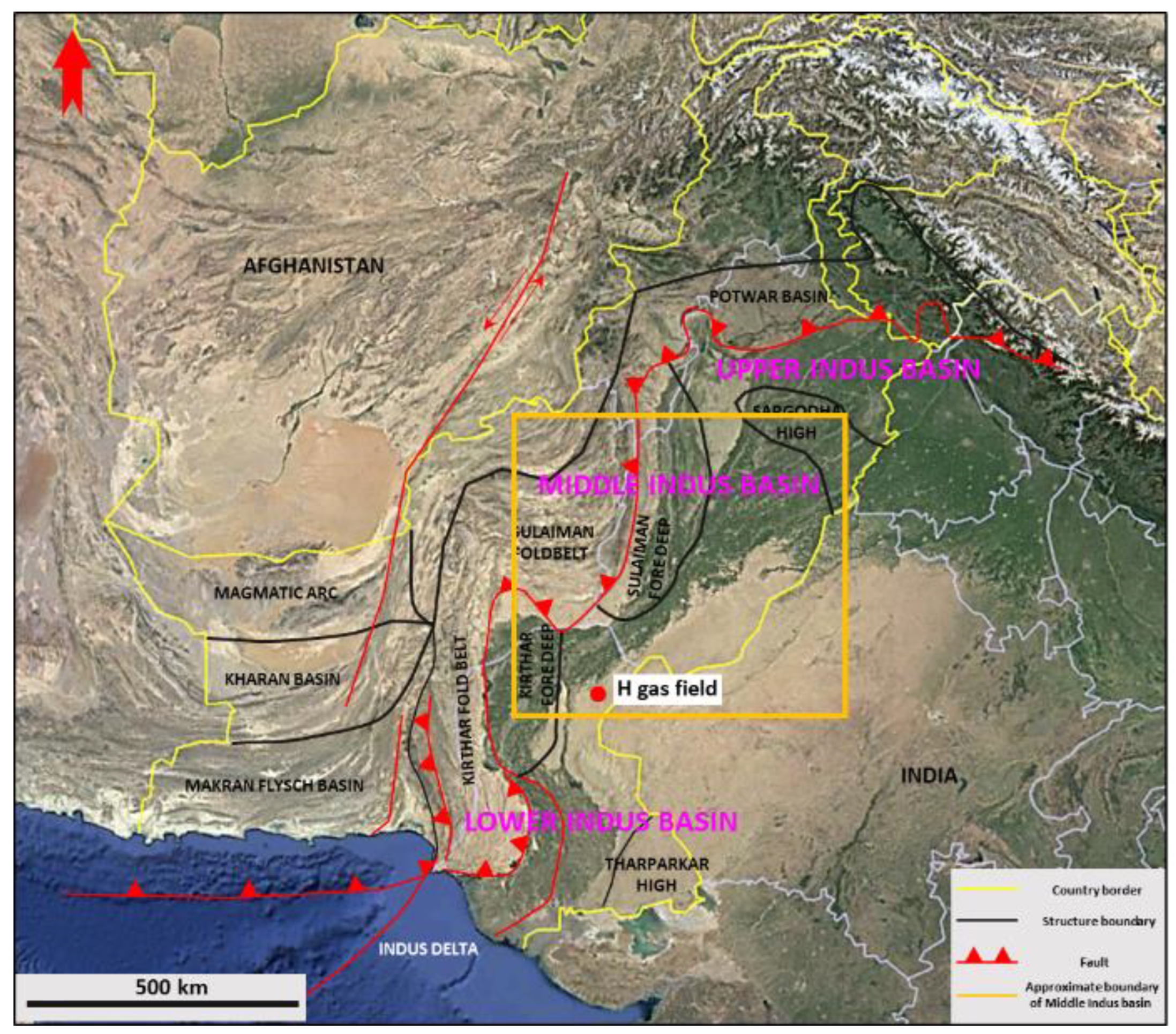
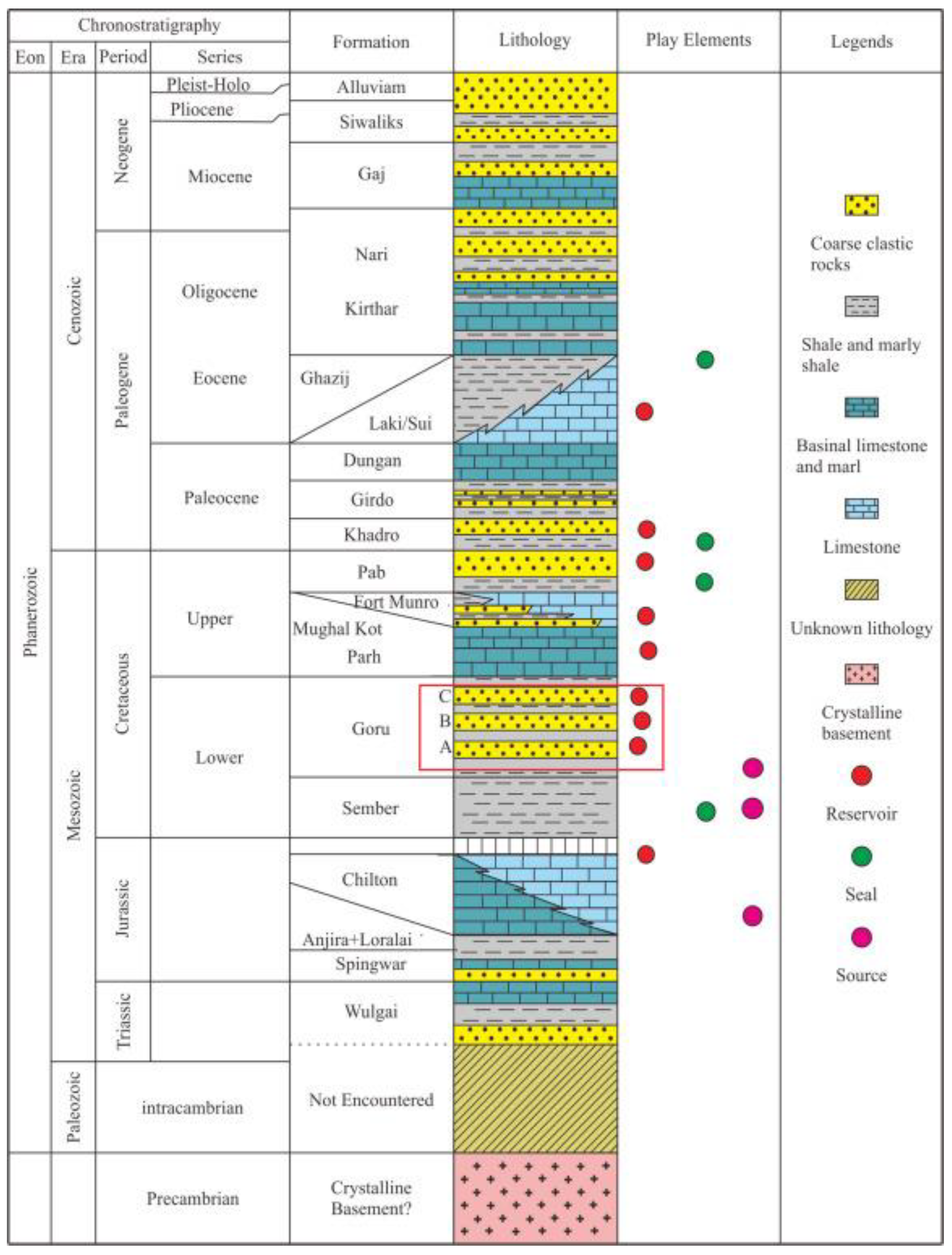

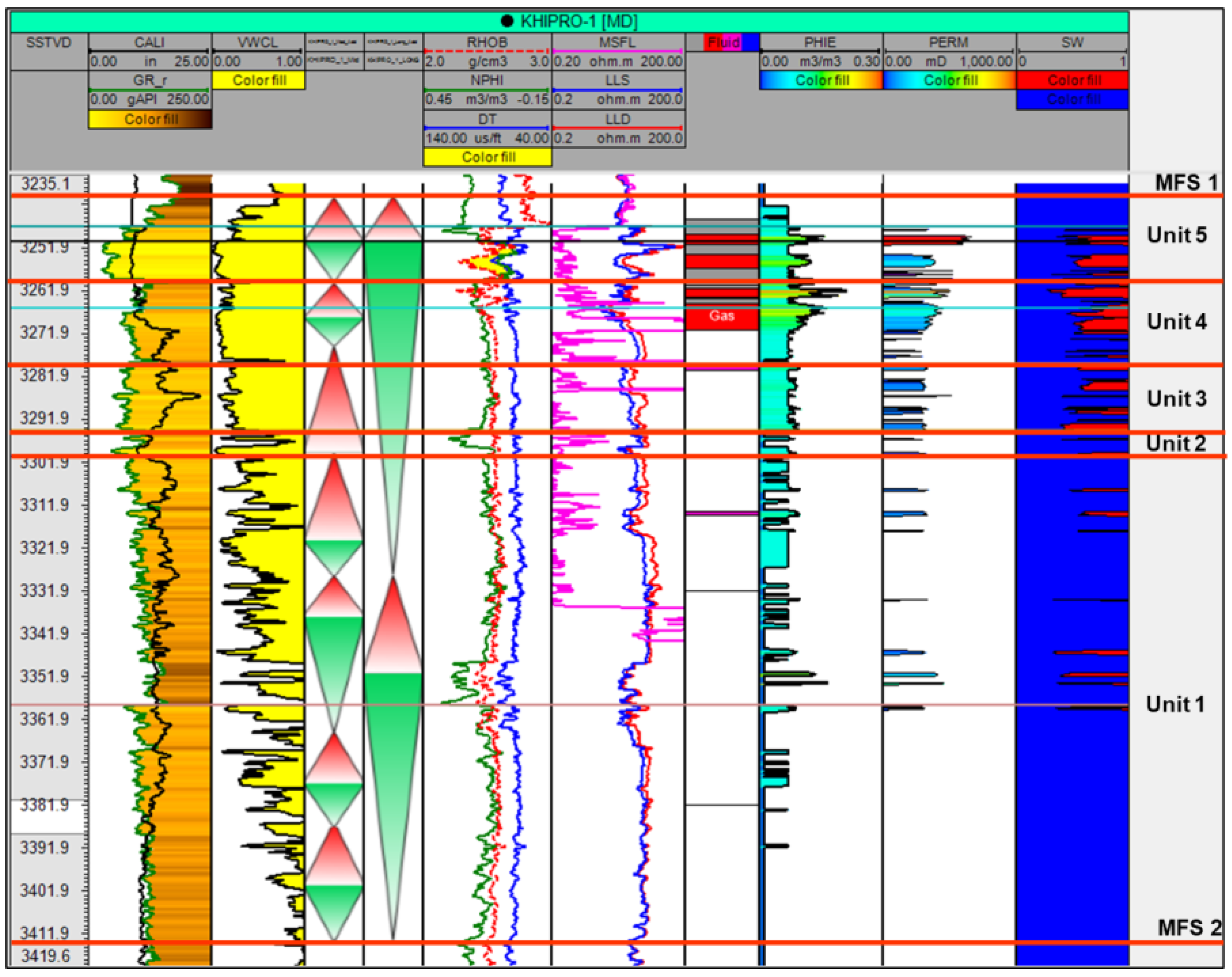
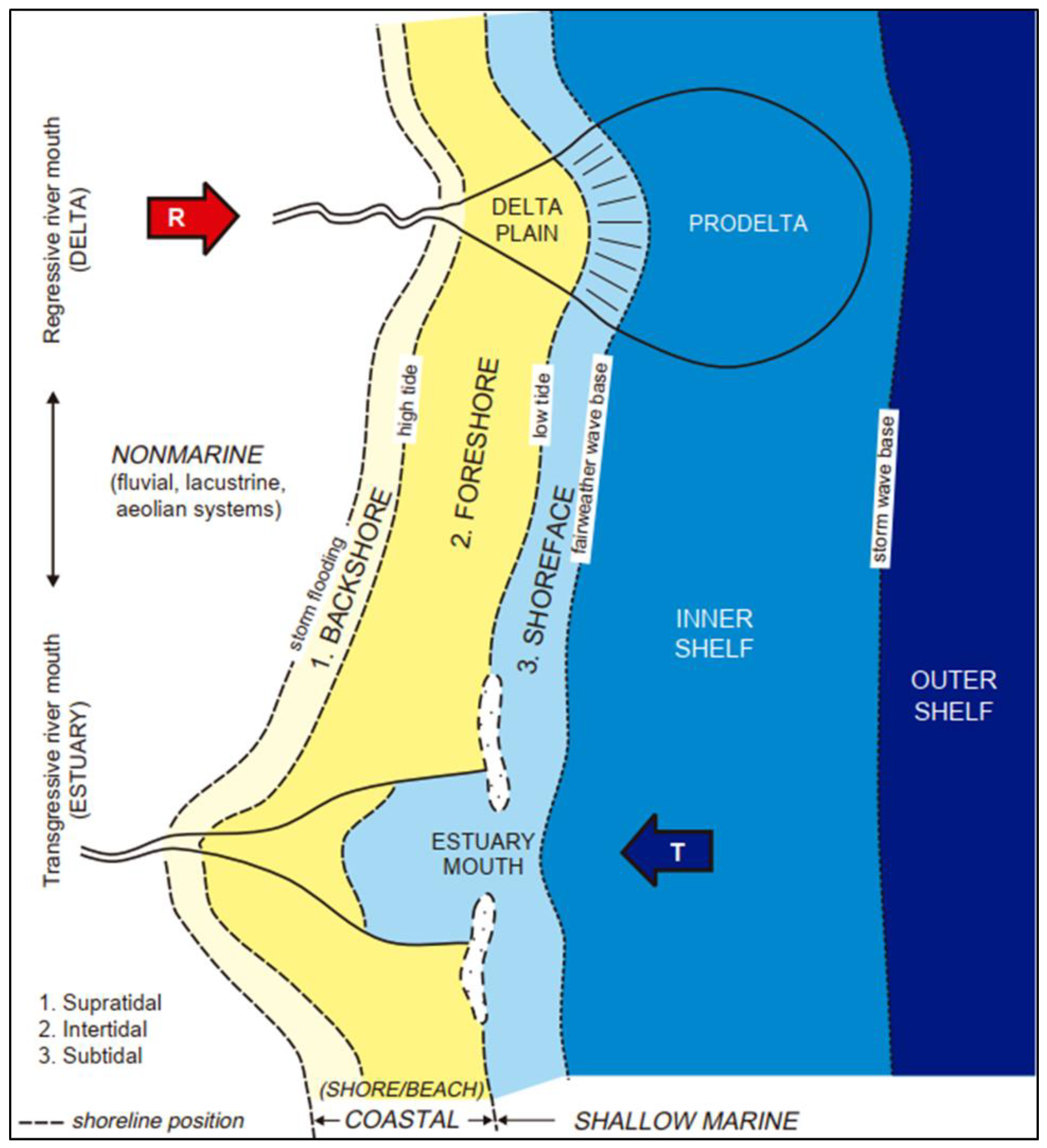
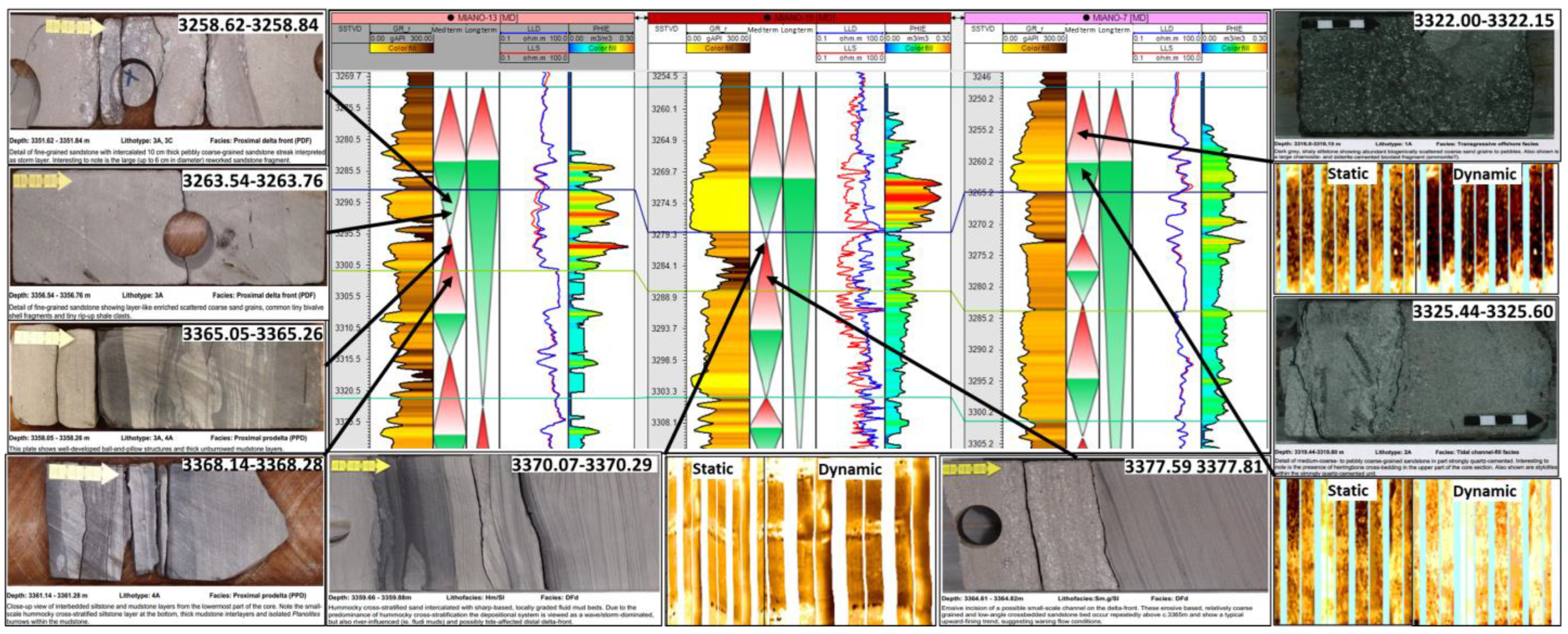
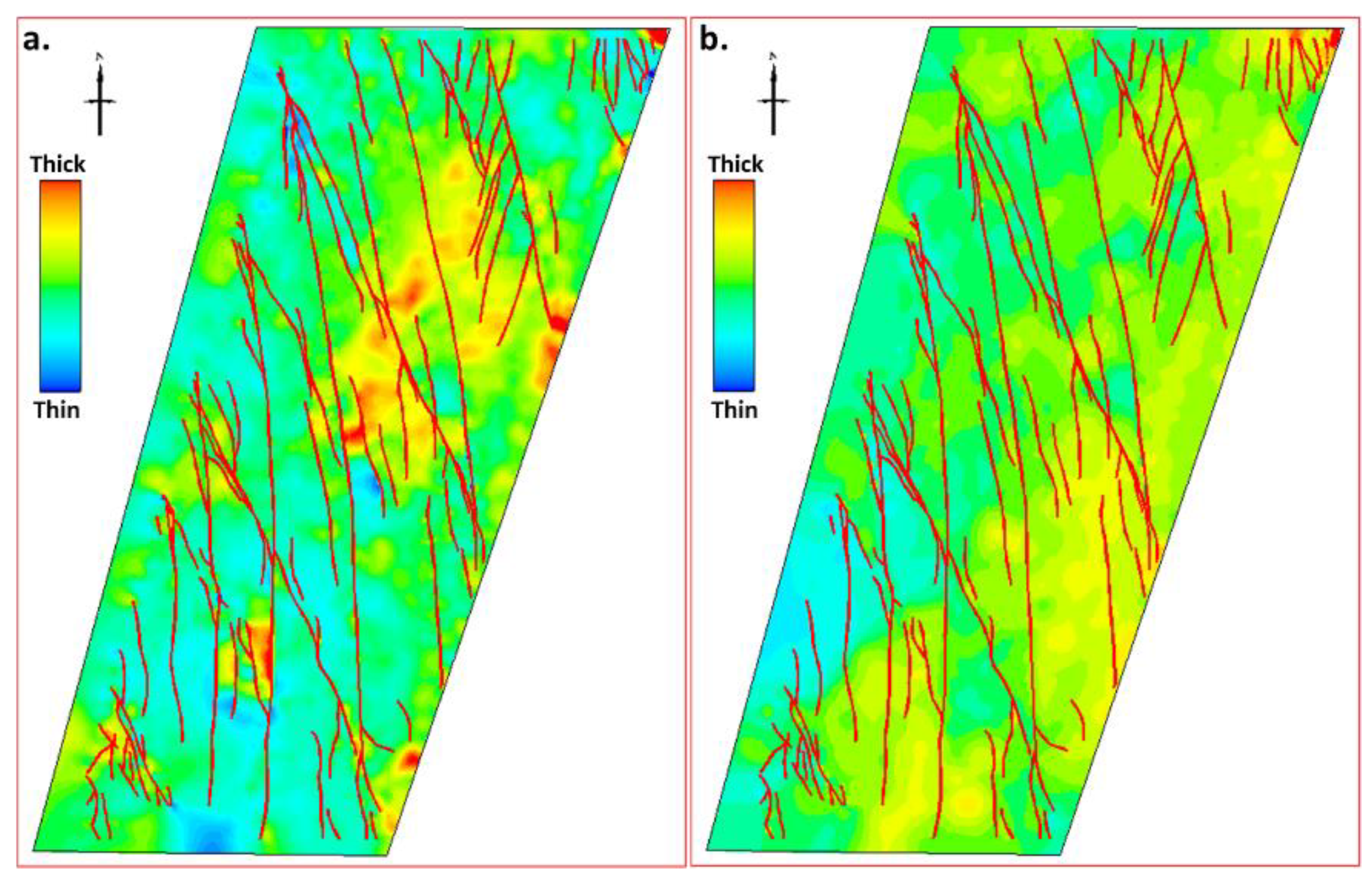

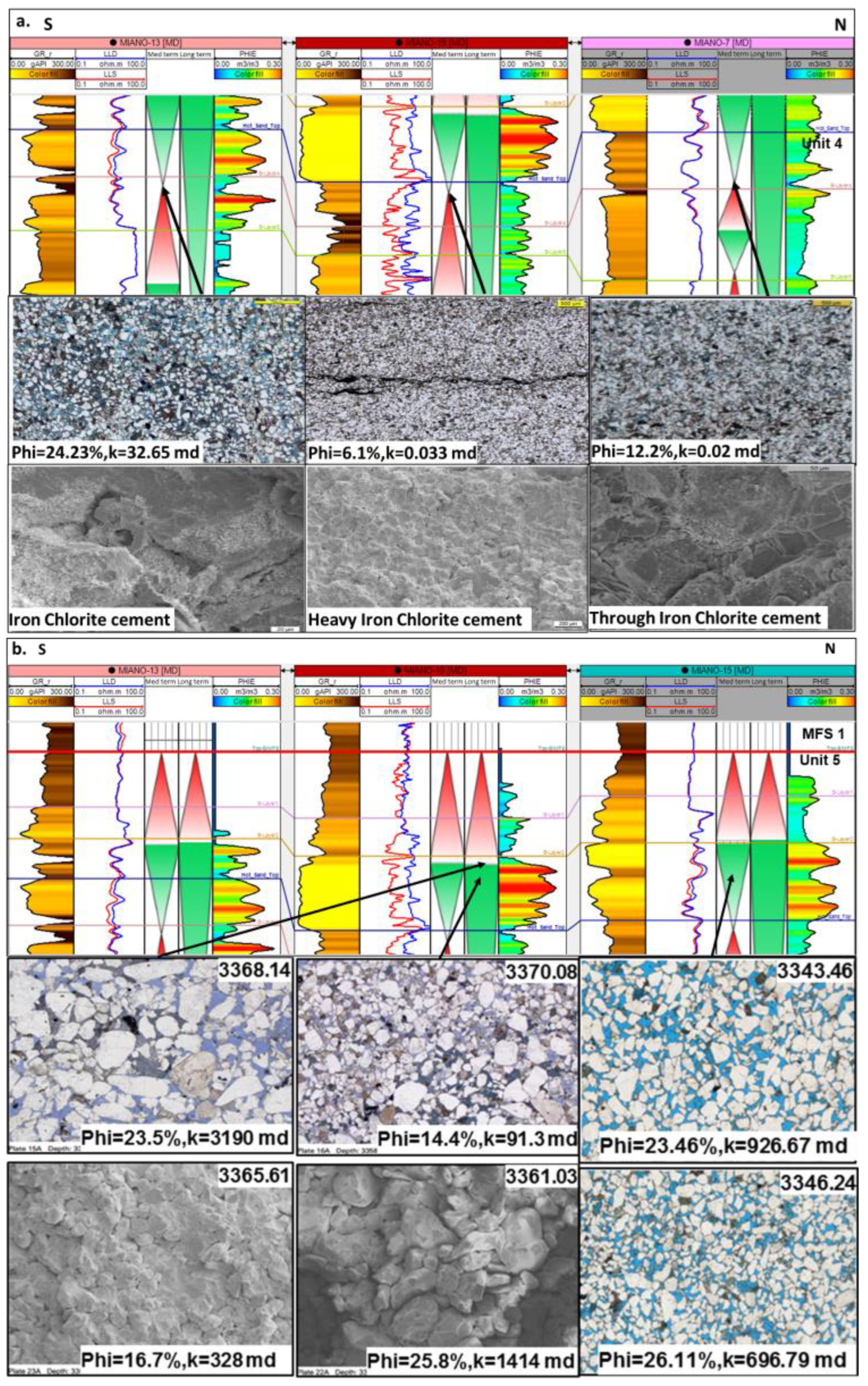
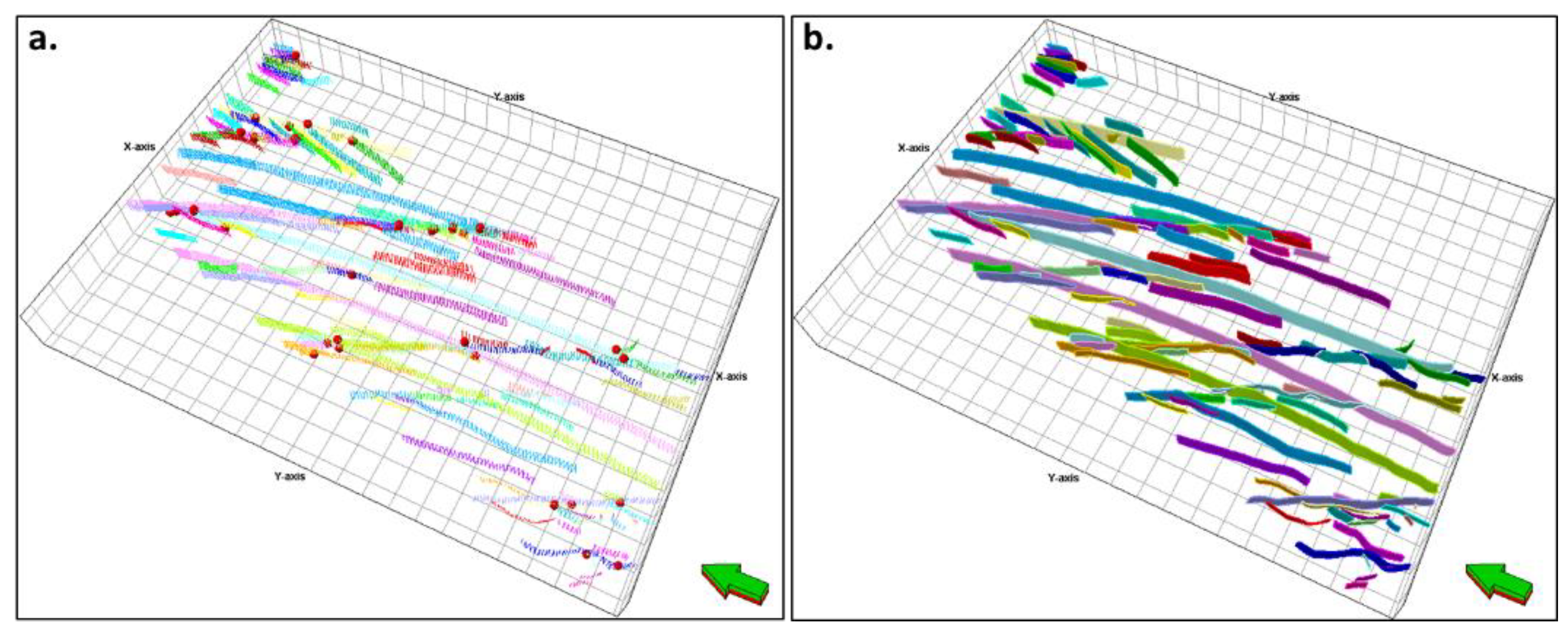



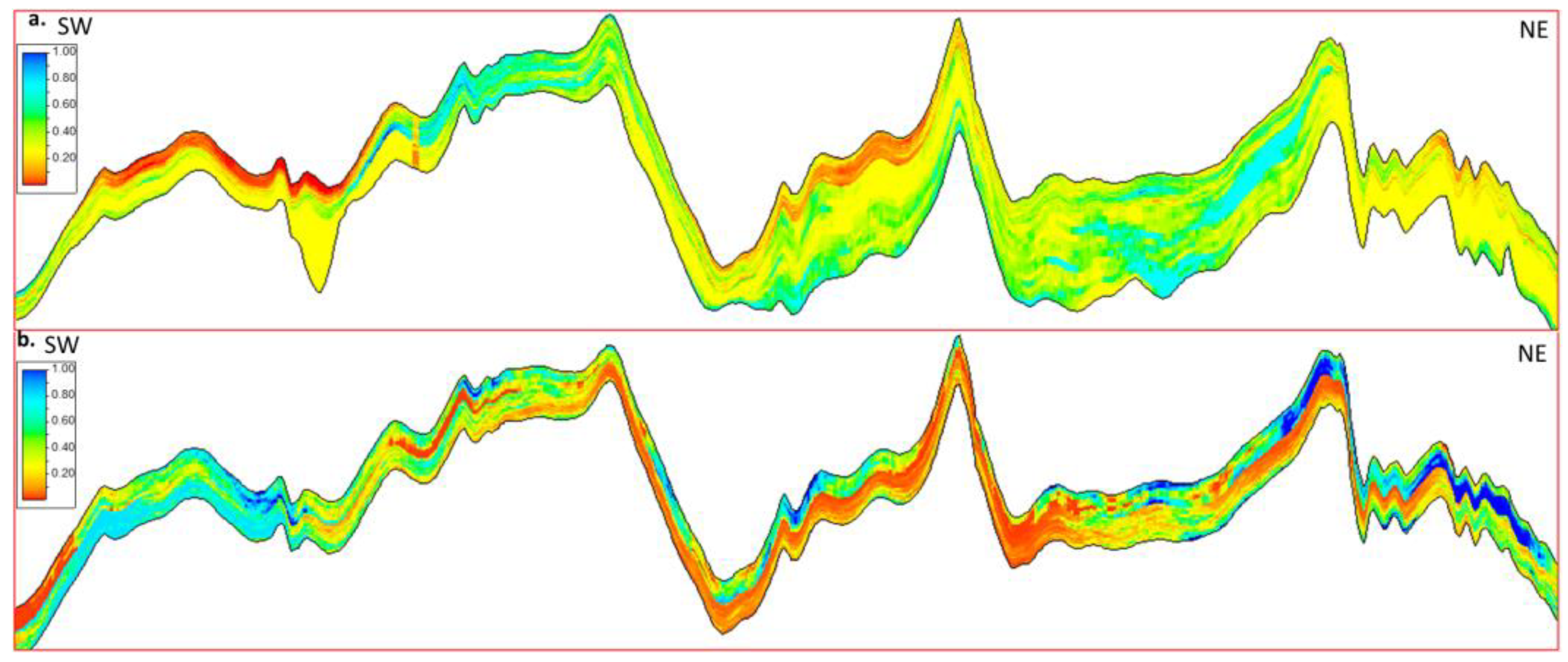
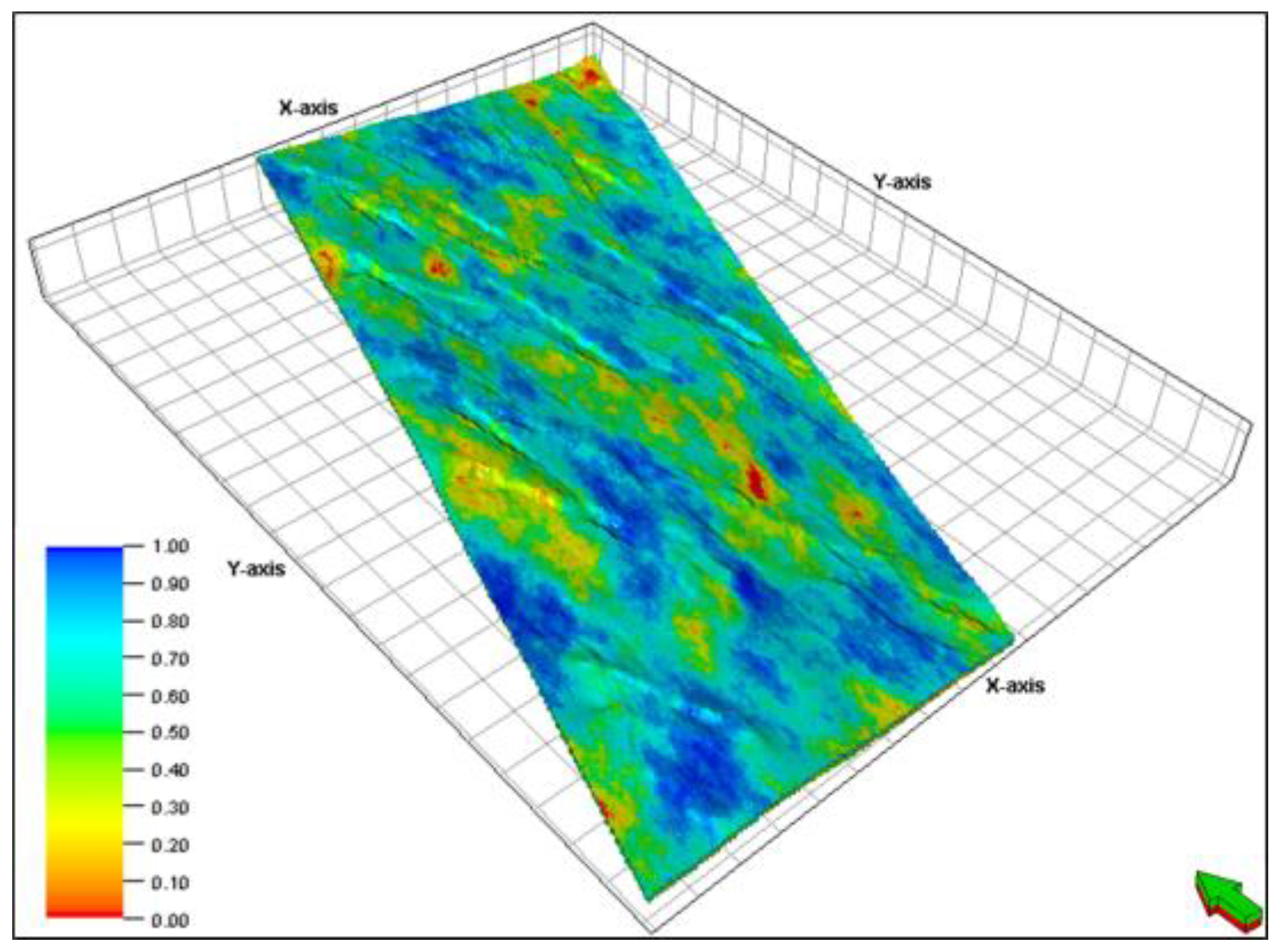


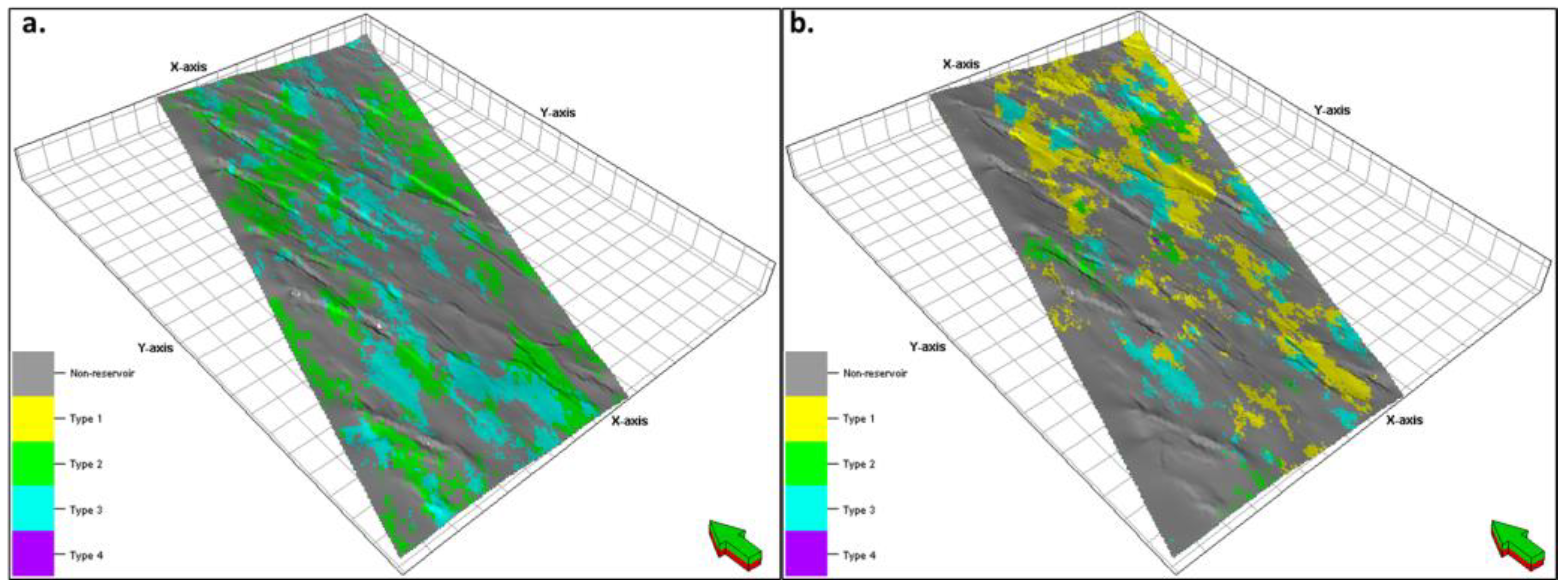
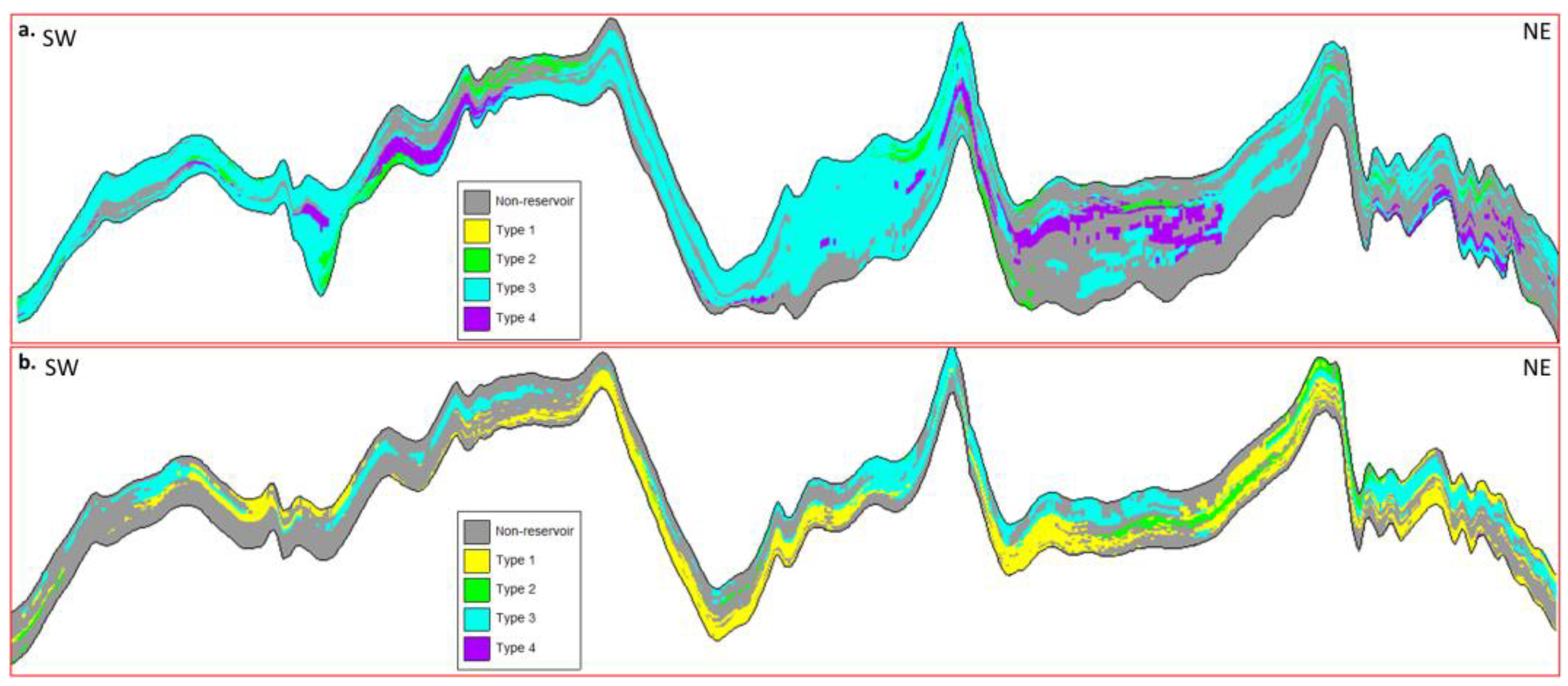
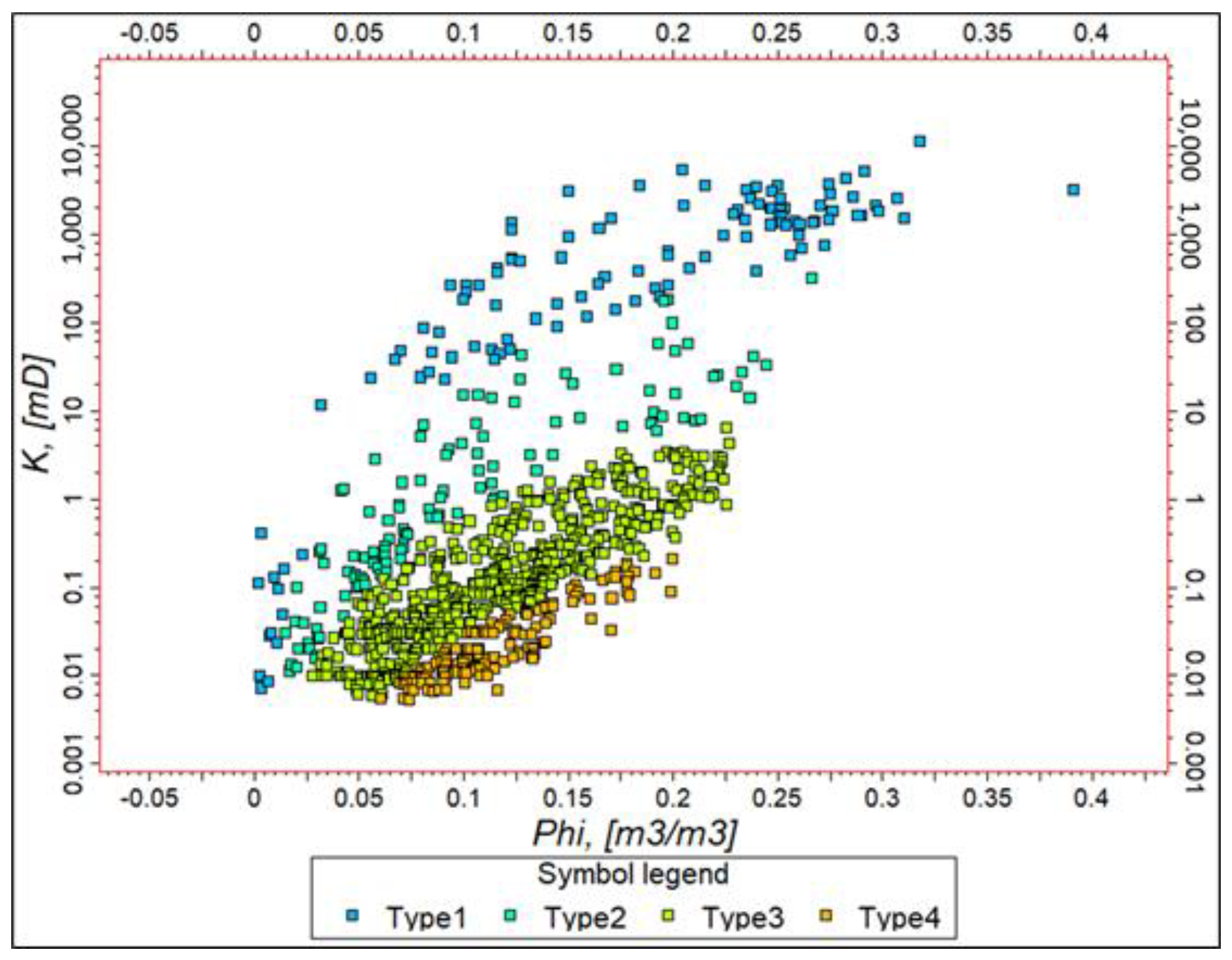
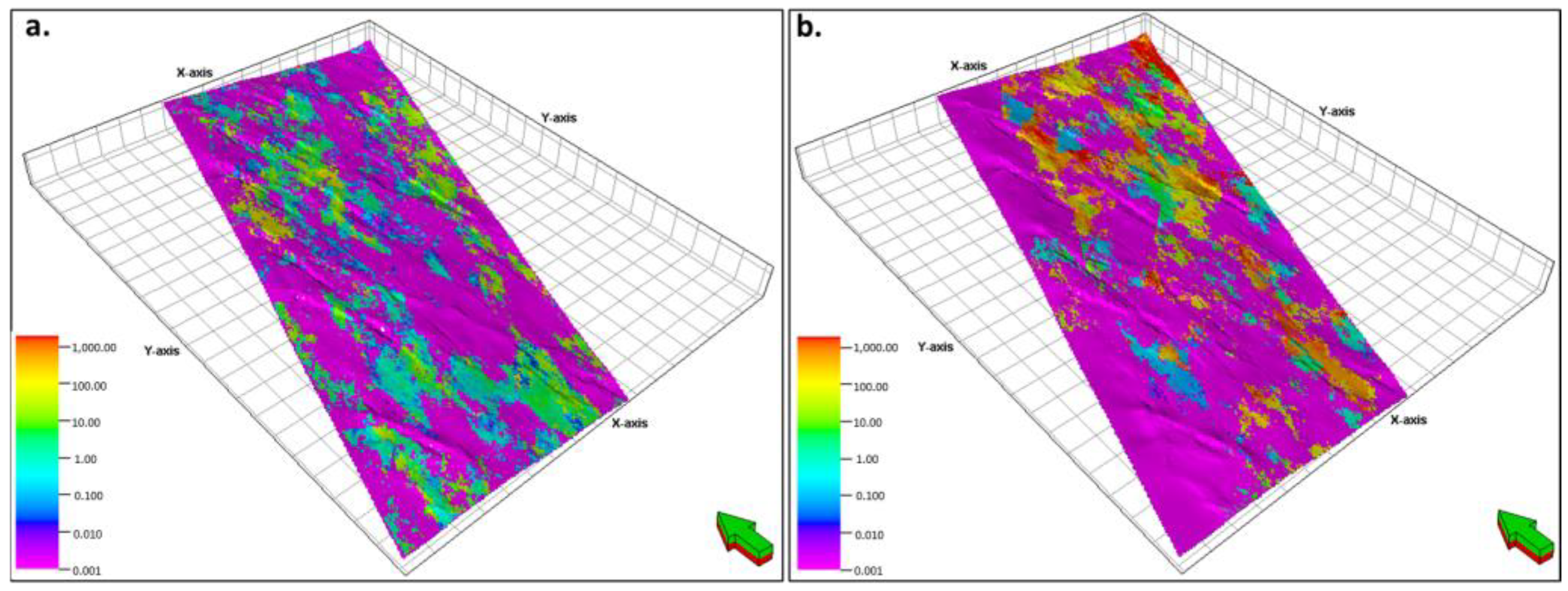
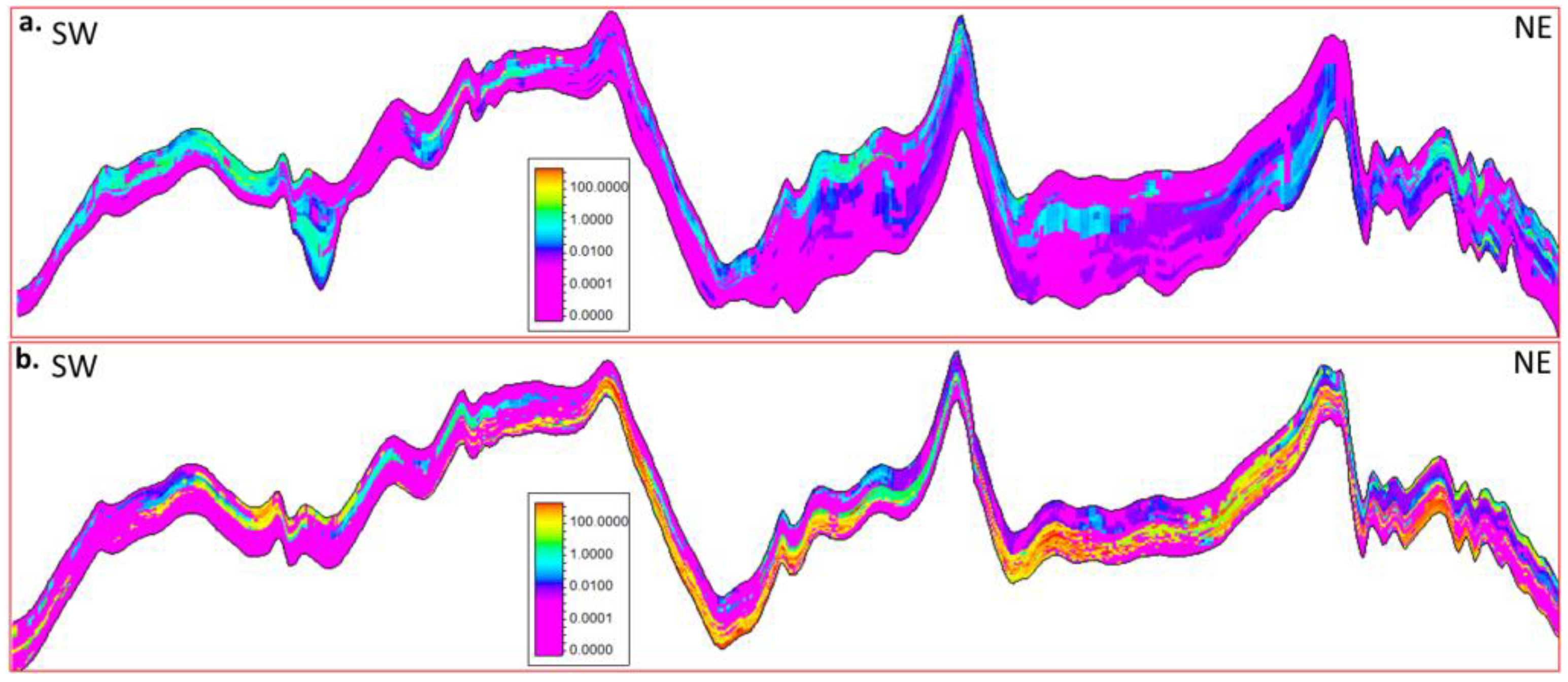

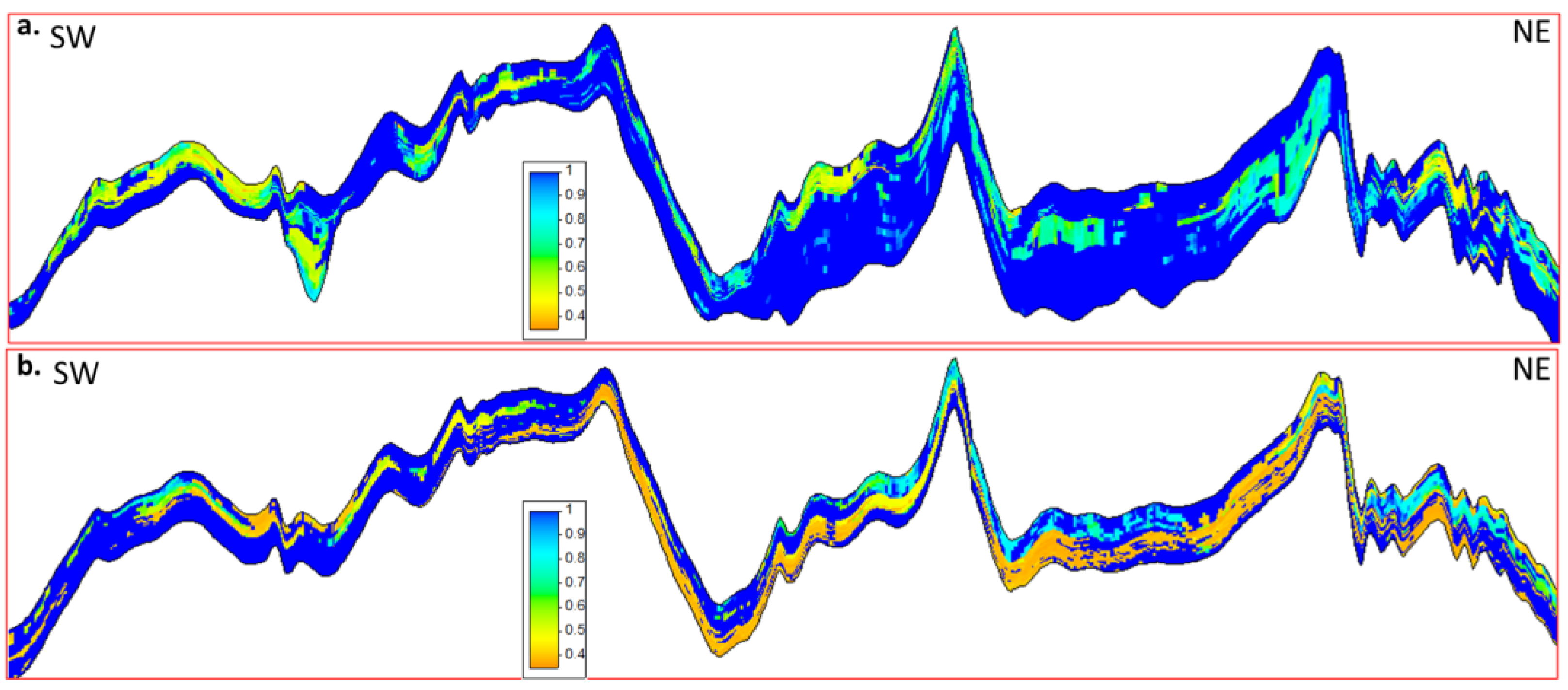
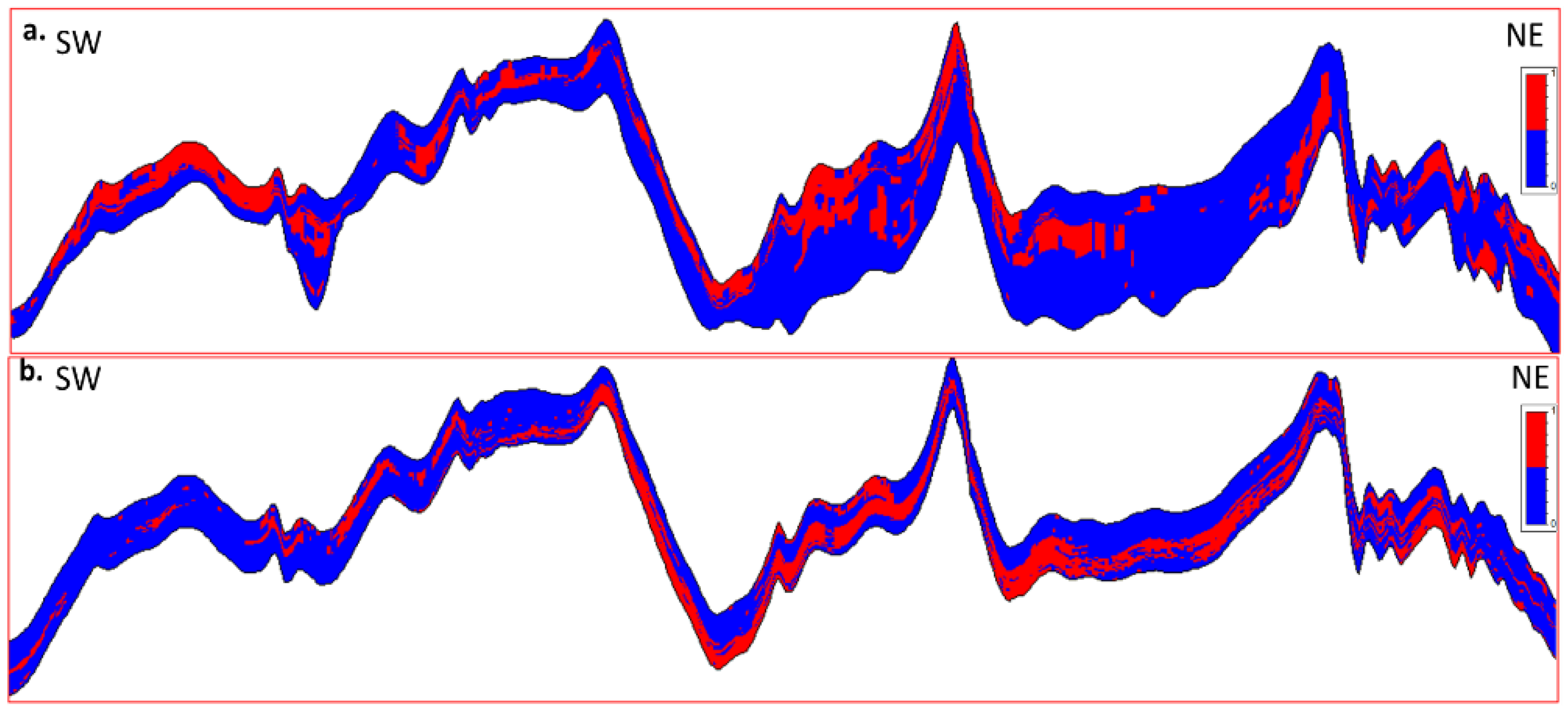
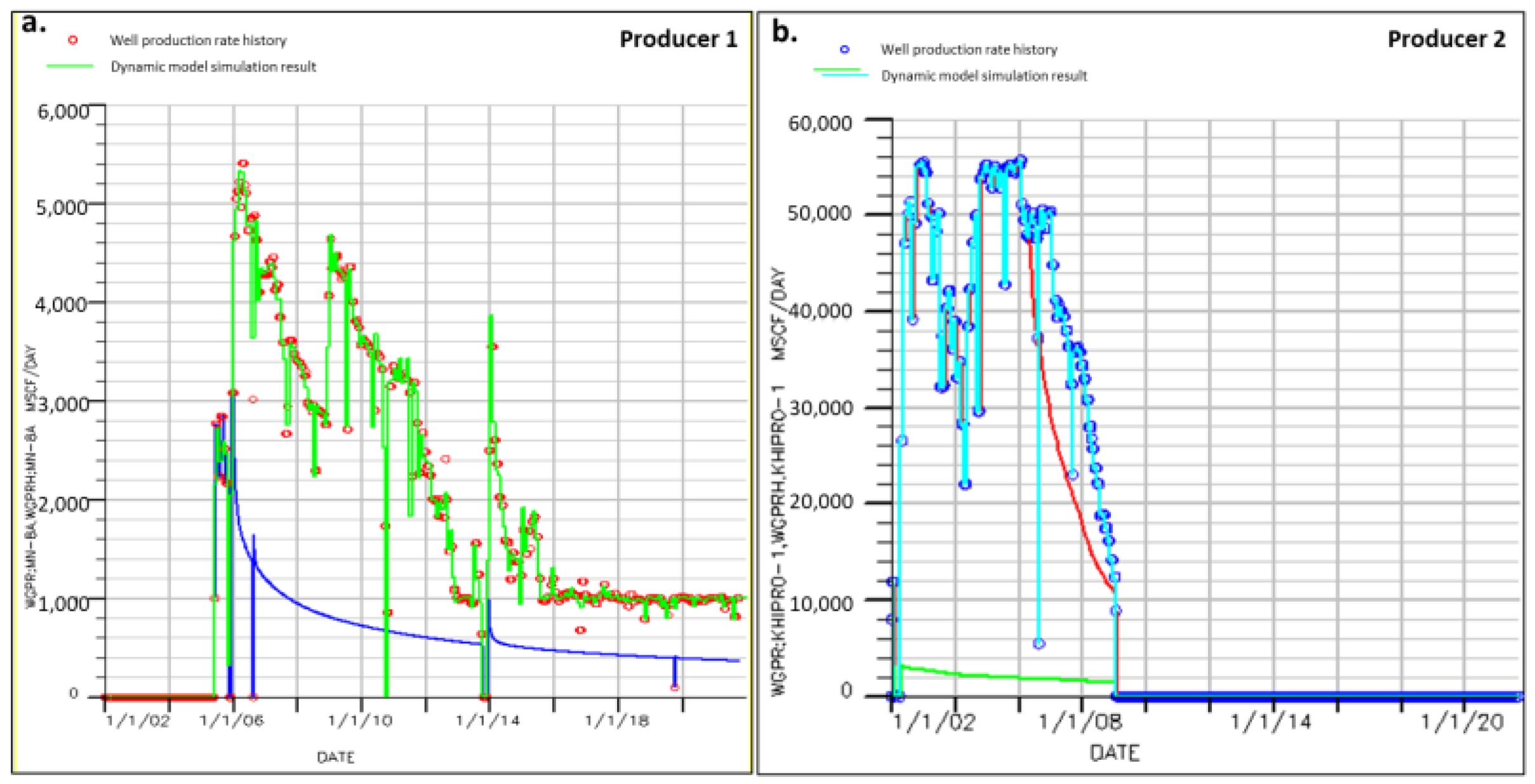

| Geologic Unit | Reservoir Unit | Lithology Description | Middle-Term Sequence |
|---|---|---|---|
| Unit 5 | conventional gas reservoir | Dominated by light grey, medium- to coarse-grained sandstone with massive bedding and cross bedding at the lower part where the conventional gas reservoir develops. Quartz cements and rip-up shale crests are observed in this part. However, the lithology switched to dark grey shaly siltstone in the upper of the geologic unit | a late descending half cycle to an early ascending half cycle (including a switch surface) |
| Unit 4 | tight gas reservoir | Dominated by light grey to grey fine-grained sandstone with low-angle cross beddings and parallel beddings. Mud layers and thin coarse-grained sand occasionally develop. Erosional surfaces and storm layers (reworked fragments) exist | in a middle to late stage of descending half cycle |
| Unit 3 | non-reservoir | Grey fine- to medium-grained sandstone to siltstone with lamination and cross bedding. Shale, burrow, bioturbation, and mud draped are observed | in an early to middle stage of descending half cycle |
| Unit 2 | non-reservoir | Light grey to grey fine-grained sandstone and dark shole with single coarser quartz grains. Connected lenses or slightly wavy beddings occasionally develop. Pyrite nodules are visible within the shale | in a late period of ascending cycle to a very early stage of descending cycle |
| Unit 1 | non-reservoir | Dark to dark green shale or siltstone. Considerable quantities of glauconite, elliptical concretions of siderites, and single pyrite nodules are visible. | a nearly complete descending–ascending cycle |
| Sample | Glauconite | Ripidolite | Chamosite Grains | Iron Chlorite | Siderite | Depth |
|---|---|---|---|---|---|---|
| 1 | / | / | 2.3% | 16.7% | / | 3358.34 |
| 2 | / | / | 8% | 13.7% | 7.3% | 3359.83 |
| 3 | / | / | 5.3% | 8% | 5.3% | 3360.4 |
| 4 | / | / | 7.3% | 21.3% | 4% | 3362.76 |
| 5 | / | / | 5.3% | 16.7% | / | 3366.99 |
| 6 | 0.33% | 2.31% | / | 10.23% | / | 3316.6 |
| 7 | 0.33% | 2% | / | 8.67% | / | 3323.56 |
| 8 | 0.33% | 3.96% | / | 12.21% | / | 3324.46 |
| 9 | / | 2.33% | / | 21.59% | / | 3327.34 |
| Injection Curve | Throat Distribution | Thin Section | SEM | Rock Typing |
|---|---|---|---|---|
 |  |  |  | Type 1 Geologic Unit 5 Porosity: 14%~27%, Permeability: 14 mD~3000 Md, Throat radius: 10–50 um. No clay mineral cementation |
 |  |  |  | Type 2 Geologic Unit 3–4 Porosity: 14%~24%, Permeability: 1 mD~100 mD, Throat radius: 3–10 um. Clay mineral cementation |
 |  |  |  | Type 3 Geologic Unit 1–4 Porosity: 7%~20%, Permeability: 0.1 mD~1 mD, Throat radius: 0.15–1 um. Heavy clay mineral cementation |
 |  |  |  | Type 4 Geologic Unit 1–4 Porosity:5%~20%, Permeability: <0.1 mD, Throat radius: 0.02–0.4 um. Through clay mineral cementation |
| Main Zone | Subzone | Ave. Thickness (m) | Layers | Resolution (m) |
|---|---|---|---|---|
| Unit 5 | Subzone 1 | 5 | 3 | 1.7 |
| Subzone 2 | 6 | 8 | 0.8 | |
| Unit 4 | Subzone 1 | 6 | 10 | 0.6 |
| Subzone 2 | 9 | 6 | 1.5 |
Disclaimer/Publisher’s Note: The statements, opinions and data contained in all publications are solely those of the individual author(s) and contributor(s) and not of MDPI and/or the editor(s). MDPI and/or the editor(s) disclaim responsibility for any injury to people or property resulting from any ideas, methods, instructions or products referred to in the content. |
© 2023 by the authors. Licensee MDPI, Basel, Switzerland. This article is an open access article distributed under the terms and conditions of the Creative Commons Attribution (CC BY) license (https://creativecommons.org/licenses/by/4.0/).
Share and Cite
Yang, C.; Zhao, C.; Meng, X.; Dong, P.; Chai, J.; Wang, X.; Nie, Q.; Yang, J.; Yu, W. Reservoir Characterization and an Integrated Approach of Reservoir Modeling for Miano Gas Field, Middle Indus Basin. Energies 2023, 16, 856. https://doi.org/10.3390/en16020856
Yang C, Zhao C, Meng X, Dong P, Chai J, Wang X, Nie Q, Yang J, Yu W. Reservoir Characterization and an Integrated Approach of Reservoir Modeling for Miano Gas Field, Middle Indus Basin. Energies. 2023; 16(2):856. https://doi.org/10.3390/en16020856
Chicago/Turabian StyleYang, Chen, Changsheng Zhao, Xiangjuan Meng, Pingchaun Dong, Junxian Chai, Xiaoming Wang, Qihai Nie, Janfang Yang, and Wenwen Yu. 2023. "Reservoir Characterization and an Integrated Approach of Reservoir Modeling for Miano Gas Field, Middle Indus Basin" Energies 16, no. 2: 856. https://doi.org/10.3390/en16020856
APA StyleYang, C., Zhao, C., Meng, X., Dong, P., Chai, J., Wang, X., Nie, Q., Yang, J., & Yu, W. (2023). Reservoir Characterization and an Integrated Approach of Reservoir Modeling for Miano Gas Field, Middle Indus Basin. Energies, 16(2), 856. https://doi.org/10.3390/en16020856






